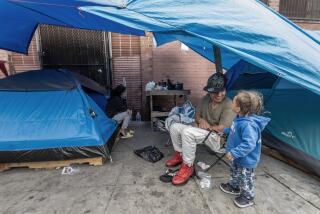‘Bushvilles’ Evoke the Great Depression : Homelessness: As shacks sprout around Manhattan, shantytowns that cause complaints are razed. Residents say they do not feel safe in shelters.
NEW YORK — Some are flimsy heaps of cardboard draped with bedsheets or garbage bags. Others are more substantial--shacks built from wood scraps, high enough to stand in. A few have ragged embellishments: a front porch built of milk crates, a bucket of plastic flowers, a piece of linoleum underfoot.
All of them are homes--of sorts.
Shantytowns, a phenomenon once associated with the Great Depression, are again a familiar sight in parts of New York City. In the shadows of the skyscrapers the homeless are improvising shelter.
Fire hydrants supply water; buckets and bushes serve as toilets. Light and heat come from candles and trash-can fires. Plastic tarpaulins keep out the rain. Electricity is sometimes tapped from street lights.
“We eat from garbage cans. Sometimes people bring us sandwiches. We pick up cans and bottles to sell. That’s how we survive,” said Julio Ayala, who built one of a dozen huts along the East River in Lower Manhattan.
“Sometimes the snow gets inside, but the next day it’s sunny,” said Hector Quita, a gray-bearded man who has lived two years in a shantytown on a vacant lot in the East Village.
Quita has a kerosene heater and a brick floor. A sign outside his door identifies the ramshackle village as “Bushville.” A larger encampment a few blocks away, dubbed “Dinkinsville” after Mayor David N. Dinkins, was razed by the city in October.
They evoke the “Hoovervilles” of the 1930s, shantytowns around the country that were named for President Herbert Hoover.
The 100 or so shantytowns around New York City today are much smaller, according to the Coalition for the Homeless. They shelter just 10 to 40 people each--a fraction of the city’s 70,000 homeless people--but they have become a symbol of just how entrenched the homeless problem is.
“Homelessness is worse in the 1980s and 1990s than it has been in 50 years, and that’s why we’re seeing these shantytowns again,” said Kenneth T. Jackson, a Columbia University history professor. “The difference is, there was considerable sympathy in the 1930s for Hoovervilles.”
Today’s shantytowns are, by and large, ignored--unless the inhabitants make trouble or the land is needed. Then the bulldozers are called in.
“We weigh the size of the encampment, the hazards and the complaints we’ve received,” said Michael Kharfen, director of the mayor’s Community Assistance Unit. “There’s no set formula, but some are more urgent than others.”
A shantytown in Riverside Park was dismantled because the state Department of Transportation had plans for the site. A camp near Central Park at Columbus Circle was swept away after urine seeped into the ventilation system of a nearby building. A squalid encampment in Tompkins Square Park was torn down because it made the park unusable for others. “Dinkinsville” was razed after neighbors complained of fires, drug deals and fights there.
In each case, Kharfen said, social workers were sent in to let the homeless squatters know about city shelters, food stamps and treatment programs.
Other, equally visible shantytowns are left alone--so long as the neighbors don’t complain. Quita’s shantytown is across the street from a public elementary school. Shacks on a Hudson River pier face the carrier Intrepid, which has been turned into a museum.
Mattresses and tarpaulins under the stone parapets of a Brooklyn garage are steps from a city jail. The streets around the Port Authority bus terminal are lined with cardboard beds and shopping carts full of broken umbrellas, dirty blankets and other ragged treasures.
A shantytown hard by the Manhattan Bridge has practically become an institution since artists built a tepee there a year ago. Residents now hand out postcard pictures of the settlement, and a photograph of it appears in a Municipal Arts Society brochure.
“You’ve got to find a better excuse to get rid of these people than the fact that they’re an eyesore,” said Gabriele Schafer, one of the tepee artists. “The last time we kicked nomadic people out--the Indians--we hated them, too. . . . The homeless have a right to be left alone.”
Opinion is divided as to whether it is more humane to let the shantytowns be or to raze them--because no one should live that way.
“Homeless people who live this way are harmed by it,” said Richard Salyer, president of the local Volunteers of America, which runs a shelter for 800 men.
“We’ve taken thousands of homeless people in the last few years out of airports, the subway system, tunnels and other places,” he added. “It’s a myth that they’d rather live in a shantytowns and bus terminals. They really shouldn’t be there, even if they say they want to live this way. They need to be coaxed into accepting services, and the majority don’t go back, provided they have alternatives.”
Tearing down the shanties doesn’t help, said Diane Sonde, head of Project Reachout, which helps the mentally ill homeless.
“They just pop up somewhere else,” she said. “You’re not resolving the problem by tearing the shantytowns down. You’re just moving it.”
She acknowledged that the city sends in social workers ahead of the bulldozers, but questioned whether the shelter system provides the kind of refuge shanty residents want.
“Most of the homeless don’t want a bed in an armory-style shelter with hundreds of others--and for legitimate reasons,” she said.
“I don’t like the shelters,” said Pepe Otero, 66, when asked why he preferred a shanty. “They put bad people and good people together in there. Two of my friends got killed.”
More to Read
Sign up for Essential California
The most important California stories and recommendations in your inbox every morning.
You may occasionally receive promotional content from the Los Angeles Times.










